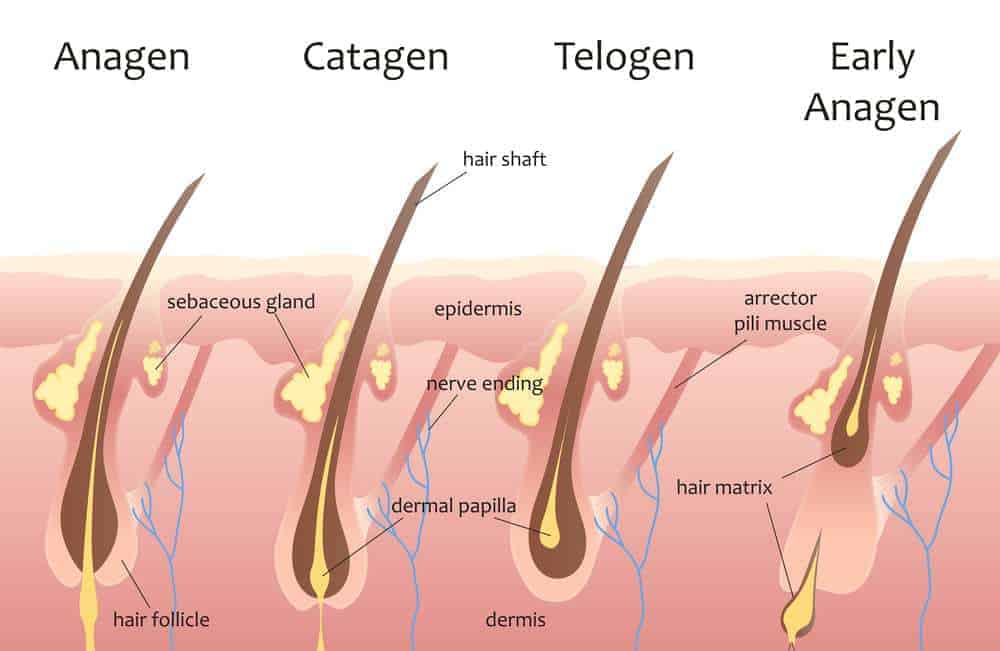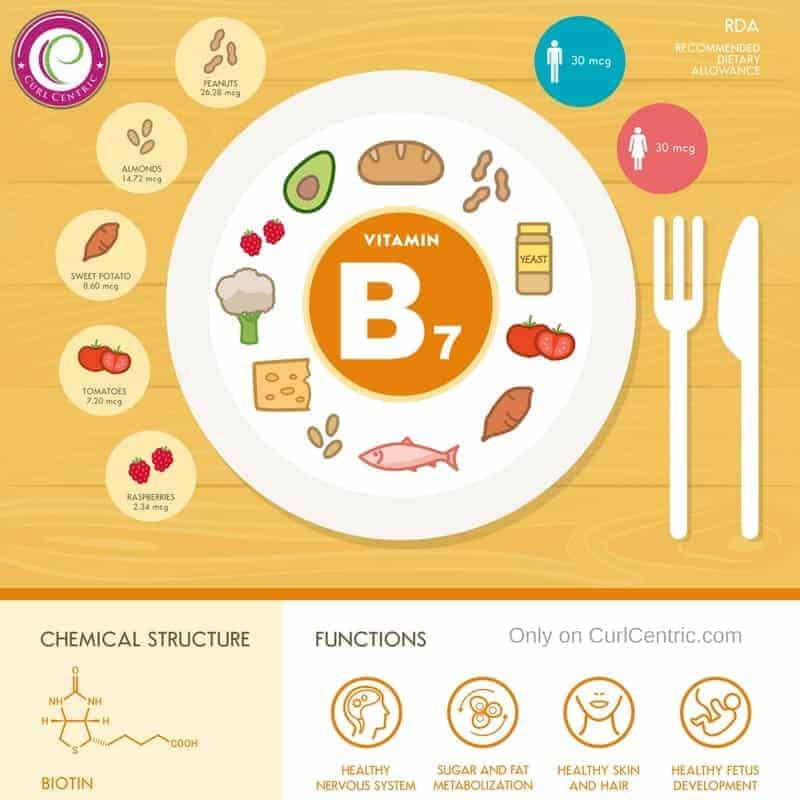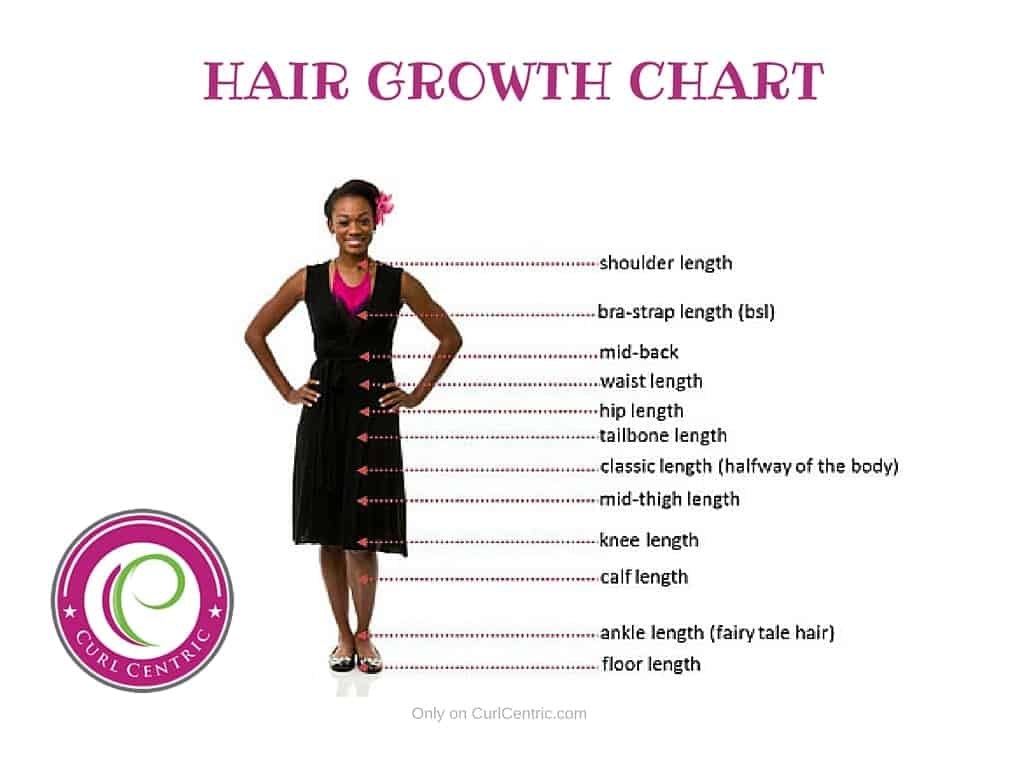
This is the most extensive, detailed guide on natural hair growth and hair regrowth, specifically covering how to make your hair grow faster, that exists online.
Lately, I've been writing more about growing long hair, but there appears to be a group of people potentially looking for shortcuts or hair growth tips to improve their hair growth rate.
I have been studying natural hair and hair growth techniques day and night for the past several years.
In this article, I will provide the information that I've gathered about growing longer hair into a comprehensive article on the topic. If you’re looking to grow long hair, this is one of the most important articles you will ever read.
Not only will you learn more about how to promote hair growth, but I will also reveal very specific reasons why you might be struggling with your hair growth.
Here is an overview of what I will cover in this article:
- The missing phase of the hair growth cycle
- Why taking biotin is entirely unnecessary for most women
- How the hair on your arms and legs knows when to stop growing
- Eight food types that you should include in your diet
- The fundamental role of water in natural hair care
- Why you have to be careful when trimming your hair
- The secret combing method that helps you retain length
- Forget the updos; let's talk about what protective styling means
Table of Contents
- 1 Overview of Natural Hair Growth
- 2 The Hair Growth Process
- 3 Should You Take Biotin for Hair Growth?
- 4 How to Grow Natural Hair Past Its Terminal Length
- 5 Does a Healthy Diet Help Hair Growth?
- 6 Scalp Care, Protective Styling & Trimming
- 7 Does Protective Styling Grow Hair?
- 8 Does Trimming Hair Make It Grow Faster?
- 9 The Secret Combing Method That Can Help You Retain Length and Reduce Breakage
- 10 Hair Growth Timeline for Females
- 11 Related Articles
- 12 Final Thoughts On How to Promote Hair Growth
Overview of Natural Hair Growth

It's only natural for people to wish that their hair would grow faster. After all, we are the "microwave generation" - that is, a group of people that are accustomed to nearly immediate gratification.
We don't write letters very often because email is immediate. We no longer go to the local library because Google and Bing are only a few clicks away.
Most movie retailers (e.g., Blockbuster) have either completely changed their business model or gone out of business because people would rather watch movies on-demand (e.g., Netflix) immediately.
The microwave generation is generally impatient. Sometimes we even find ourselves in front of the microwave, wondering why it's taking so long to cook that Lean Cuisine.
This is especially true for women who like to change their hairstyle(s) often or who are unhappy with their current short haircut.
Alright, enough with the introduction; here are the main things that you need to know about how to grow your hair faster.
The Hair Growth Process

Hair growth is about time, but not only about time. Numerous factors determine the rate of hair growth, but the most important one is time.
There simply is no substitute for just letting your hair grow.
You can do things to encourage and enhance the growing process (i.e., promote hair growth), but nothing is more of a factor than the passage of time.
Hair growth is a process, and for your hair to be healthy and look its best, that process must be carried out in full, and that process requires time.
The average person's hair grows about half an inch a month or approximately six inches per year.
Some ethnic groups tend to be above or below the mean.
Still, since the world has become such a melting pot and considering the theory of miscegenation, I typically don't dive into norms related to various ethnic groups since the norms are so difficult to apply.
Frankly, these differences are not enormous and can sometimes be completely erased by genetic factors.
Some people naturally have hair that grows faster or slower than others.
The good news is that regardless of your natural hair growth rate, your hair is always in the process of growing on a 24-hour basis. Hair growth tends to follow a pattern.
Most of the time, when growing out your natural hair, you will notice an increase in your hair's thickness before you notice an increase in length.
Beware of comparing your own growth characteristics to others, as what is normal for one person may not be normal for you.
It is also worth mentioning that you are not always the best judge of how fast and how well your hair is growing because of your over-familiarity with your hair.
You look at your hair and study it every day, making it difficult to appreciate subtle changes that others who see you less frequently will notice immediately.
Chances are your hair is actually growing faster than you realize.
I have written extensively on hair growth cycles previously, so I will only briefly cover growth cycles within this article.
In my previous article, I discussed the three common hair growth cycles - anagen (growth), catagen (regression), and telogen (rest). For years, the shedding function of the growth cycle has been thought to be a part of the telogen phase.
While reporting it this way is considered accurate (see the graphic above), according to the Journal of Investigative Dermatology, exogen (shedding) is the "official" name for the shedding phase of the growth cycle.
To be completely accurate, shedding occurs throughout the hair growth cycle.
Should You Take Biotin for Hair Growth?
Now, let's discuss the reason why taking biotin is considered unnecessary.
The Institute of Medicine, a national agency responsible for setting daily requirements for nutrition values, recommends that an individual intake only 30 micrograms of biotin per day. They haven't "recommended" a safe upper limit for biotin intake.
While it's true that many naturals have taken high doses of biotin without any major adverse effects, there are many misconceptions about the vitamin.
The body doesn't absorb excessive amounts of biotin, so increasing your intake is likely worthless.
Biotin is a water-soluble vitamin, which means that excess biotin will not be absorbed, and your body will flush it naturally.
The key takeaway is that we don't recommend taking any dietary supplements (including Biotin) unless you receive prior approval from a medical professional.
How to Grow Natural Hair Past Its Terminal Length

A common concern of those wondering how to grow natural hair is the concept of "terminal length," which is the notion that some people's hair can only grow so long and no further.
This has less to do with genetics than it does with taking proper care of your hair.
As your hair gets longer, it can tend to break unless you make an effort to practice protective styling, control your hair's exposure to extreme heat, and make sure that your hair has the protein and moisture it needs.
It's likely fair to characterize "terminal length" in the following manner: inappropriate hair care is likely more of a factor for any limited growth you're experiencing than a natural limitation on your ability to grow long hair.
Yet, no matter what you do, there is no way to prevent the hair growth cycle from placing some limitations on growth.
Every individual hair on your head has a growing period, after which it will fall out and be replaced by a new strand of hair. This hair loss is a normal part of the growth cycle.
Fortunately, the rate at which this process takes place is different for each hair, so the numerous hair strands on your head are never simultaneously in the process of falling out and being replaced all at the same time.

Obviously, that would be terrible if all your hair was shed at once. You would be confronted throughout your life with recurring periods of complete baldness (not that there is anything wrong with that).
A typical hair has a "life" of between two and six years. Therefore one of the barriers to growing your hair faster (or promoting hair growth) is where your old or damaged hairs are in the growth cycle.
It may be necessary in order to reach your hair growth goals for your damaged hair to reach its telogen phase and fall out.
As healthy new hair grows and you begin to take care of it properly, you should achieve greater length retention.
Obviously, this process takes time (there is that word again), but it is necessary to achieve your hair length goals. There is simply no substitute for good hair care over an extended period of time if you plan to grow long hair.
Despite genetically determined growth and resting phases for the hair, most people can successfully get their hair to middle back length. It would be uncommon to have a maximum hair-growing length of less than one foot.
These measures are based on the same natural restrictions on hair growth that prevent our eyelashes or the hair follicles on our arms from growing too long.
Many people point to dreadlocks as evidence of unlimited hair growth, but that is misleading since dreadlocks are formed by matting hair that would otherwise have split or fallen out.
If we assume that everything is optimal for growing your hair in terms of genetics and quality hair care (i.e., you're doing everything within your power to boost hair growth), here is a guide on how long it should take to reach specific hair length goals:
Armed with the information that the average growth rate is ½ inch per month, if you're retaining significantly less than an average of ½ inch, there might be an opportunity to dig into your hair regimen and make sure you're meeting the needs of your hair.
Starting a natural hair journal can help you quickly learn more about the wants and needs of your hair.
Regardless of your hair goals (armpit length, bra strap length, or some other length), the key to reaching these lengths in the fastest way possible is to practice excellent hair care.
Does a Healthy Diet Help Hair Growth?

Just like the rest of your body, your hair and the way it looks and grows are dependent on your overall health.
Having the right nutrients in your body will determine how fast and how well your hair grows.
Hair is heavily dependent on protein, so make sure you get enough of it through the foods you eat - examples include steak, fish, chicken, eggs, tofu, legumes, and beans.
Fruits and vegetables also contain nutrients that promote hair growth, so eat plenty of those as well.
Vitamin A, vitamin C, niacin, and biotin are vitamins that many people believe will lead to healthier hair and increase your hair growth potential.
So, taking a multivitamin supplement that contains these vitamins is the best approach (if you decide to take an oral supplement). Again, be sure to check with your medical doctor before taking oral hair growth supplements.
I have touched on this briefly, but here is another quick note about biotin. Scientific data doesn't support the claim that biotin improves or promotes hair growth. Regardless of this fact, biotin deficiencies are extremely rare.
The chance that your body doesn't have the proper amount of biotin already is very slim since intestinal bacteria produces biotin in excess of the body's daily needs.
For more specifics about why we don't recommend taking biotin supplements, check out this article: Does Taking Biotin For Hair Growth Really Work?
Also, you must avoid activities or practices that negate the beneficial effects of eating a healthy diet, such as smoking, excessive alcohol consumption, and other unhealthy practices.
So, establish a healthy, balanced eating plan.
It's generally considered best practice if you plan your meals for maybe a week at a time. This will allow you to make sure that you have the proper ingredients to make the meals.
Check with your doctor first, and if necessary, you can incorporate an over-the-counter multivitamin into your daily routine.
I don't recommend taking biotin unless it's specifically suggested by a medical professional. Otherwise, you're likely just wasting money.
Here are 8 food types that I recommend incorporating into your diet:
No. 1: Want to reduce the price of "gas" and add protein to your diet? Then, eat your beans. Maybe the gas comment was unnecessary, but you get the point. Beans are a great source of protein and other nutrients.
No. 2: Asparagus and spinach, anyone? What about broccoli? Surely you can find a few vitamin-packed dark green veggies to incorporate into your diet.
No. 3: Nuts aren't just for squirrels and psychiatrists. Get it? Nevermind. Some nuts benefit the scalp, like brazil nuts, while others are great sources of zinc and other nutrients. According to many experts, for example, Columbia University Health Services, proper zinc intake can mitigate excessive hair shedding. Zinc can be obtained through many other foods besides nuts, like meats and cheese as well.
No. 4: What's your favorite egg dish? I really like a good frittata or quiche, while my daughter prefers her eggs lightly scrambled (no cheese). Regardless of how you prefer your eggs, they provide a great protein source for your diet and are always a staple in my meal plan.
No. 5: Vitamin A promotes a healthy scalp, so look for foods packed with this vitamin. How about raw carrots? Sounds good.
No. 6: Yogurt, milk, and even cottage cheese are great options to incorporate into your diet. They provide good sources of calcium, protein, and other nutrients. Wait! Is it too late to remove cottage cheese? I'm not too fond of the way that stuff looks.
No. 7: Whole grains can add a nice dose of zinc, iron, and B vitamins to your diet. I would recommend adding a few whole-grain foods to your diet, like whole-grain bread, cereal, and rice.
No. 8: Finally, chicken, turkey, lean beef, and salmon provide high-quality protein sources – in addition to other nutrients.
Bonus Tip: While it's true that drinking water doesn't directly lead to increased hair growth, being properly hydrated is an important factor in your ability to retain length.
Several different areas of the body are made up of mostly water. When your body is dehydrated, the critical areas of your body that need water for your survival will receive water first.
As you might have imagined, your hair isn't at the top of the list. So, your hair needs water – inside and outside.
Scalp Care, Protective Styling & Trimming

Everything starts with a healthy scalp. Once your hair begins to grow from your scalp, it's your job to protect it.
Your scalp is the place on your head where your hair is actually growing from, so it shouldn't be surprising that proper scalp care is essential to promote healthy hair growth.
When you're trying to grow your hair faster, good blood circulation is an important factor, which can be stimulated by a daily scalp massage.
It doesn't have to be time-consuming; use your fingers to massage your scalp in a circular motion for about five minutes a day.
If you like you can also use natural oils such as coconut oil (learn more), rosemary oil, argan oil, mineral oil, and olive oil. Read this article on essential oils, for more hair oils that you can use for increased hair thickness.
Other important factors to ensuring that you have a healthy scalp include avoiding product build-up, using gentle products, avoiding extreme heat, and eating a balanced diet.
Does Protective Styling Grow Hair?
Protective styling is also really important. When I talk about protective styling, I'm not specifically referring to protective hairstyles, which are different.
Wearing updos and French rolls is all good and beneficial, but it's not really what I had in mind.
The protective styling process that I'm referring to is really about making sure that you're constantly doing things that protect your hair from damage.
So, it's more so about the process used to style your hair and not the actual style you decide to wear.
Here is an example, if you're going to utilize heat on your hair, there are precautions that you need to take to mitigate the possibility of incurring heat damage.
One thing you might do is use a heat protectant, but to really mitigate heat damage; there are many other things that you will want to consider.
This is starting to sound cliché because I've said it a lot recently, but it's really about increasing the number of good things that you do for your hair and eliminating the bad things.
The ends of your hair are the oldest parts of the hair. You have to work to preserve the ends if you really want long hair. So, one of the primary keys to getting long hair is the concept of length retention.
If you don't handle your hair with care, it will be more prone to break, and you will "struggle to grow long hair." Every single time you touch your hair, it becomes weaker - generally speaking.
That's the reason that many women preach low manipulation styles (i.e., protective hairstyles) and protective hair care.
Does Trimming Hair Make It Grow Faster?

Trimming your hair does not make it grow faster; it only makes it shorter. Only trim your hair when necessary. Please do not trim your hair monthly or at any specific interval. This is almost always terrible advice.
Plus, if you consider that the average growth rate for hair is approximately ½ inch per month, then you're likely to cut most (or all) of your new growth off if you trim every month.
I do suggest that you watch for split ends and carefully trim them away as needed. This will ultimately mitigate the possibility of split ends causing problems for your hair growth goals.
Trimming your hair when it's dry is the safest approach due to various things, but just know that it's likely to be less damaging to the hair strands.
The Secret Combing Method That Can Help You Retain Length and Reduce Breakage

You could wear some hairstyles that don't require much manipulation/combing (i.e., protective hairstyles), but many hairstyles require you to comb your hair more often.
Just keep in mind that combing improperly can cause significant damage to your hair. Don't comb or brush your hair more than you have to and always make sure your combs are clean.
Dirt, chemicals, and hair oils that accumulate on dirty combs can also damage your hair.
Use wide-toothed combs that do not yank on your hair or pull out strands of hair when combing. Be gentle with your hair when you comb it.
Oh yeah, the secret method of combing that can help you retain length is finger combing. Finger combing isn't really a "secret" combing method, but it works well for many women with natural hair.
Hair Growth Timeline for Females
There are many variations, but this is one of the most common hair growth questions. How long will it take to grow my hair out?
Unfortunately, it’s also a question that is hard to answer. Many factors determine the length of time it will take for someone to grow their hair to a certain length.
The overall purpose is to help you understand how to create a natural hair routine that will stimulate hair growth.
As you go through the information included here, remember that the time estimates for growing your hair to certain lengths are only estimates.
No one knows (exactly) how long it will take your specific hair to grow. It's an impossible question.
With that context, many factors influence hair length goals, including your genetics.
Growing your hair will take years of diligent, consistent care. While many people are interested in growing long hair, they often don’t realize that growing long hair requires a significant investment of time.
Magical potions, creams, hair growth supplements, and unrealistic goals that promise fast hair growth results but fail to deliver on their promise make it very easy for ladies to become discouraged.
The only tried and tested method for growing hair is the good old-fashioned virtue of patience. Time never fails!
The Typical Hair Growing Experience

Changes in the feel, thickness, and look of your hair will come first. This is usually within the first three to four months of your hair growth journey.
That's when you'll notice improvements in thickness, and that will usually happen even before you see any additional hair length.
Seeing a difference in length will usually happen around six to eight months after you have started your hair growth journey, provided you’ve been diligently taking care of your hair.
Below is a timetable of hair growth rates (expectations). Please note that this is a very "general" timeline. It's not something that you should expect to be 100% accurate; it's a basic estimate.
Our hair growth rates can vary widely. Your growth rate is likely to differ significantly from our timeline. Consequently, I'm a little bit hesitant to post this, but it may be useful for some people, so here goes.
How Long Will It Take to Grow My Hair Out?
Shoulder Length:
Assuming that you're starting from a freshly shaven head, it should take about 2 to 2 ½ years for your hair to reach shoulder length with a proper natural hair regimen.
Armpit Length:
Between bra strap length and shoulder length lies another common hair length milestone known as Arm Pit Length (or APL).
Arm Pit Length is defined by an imaginary line drawn across your back where your arm meets your back (or armpit) and travels across to the other armpit.
Growing your hair to armpit length, from shoulder length, could take anywhere from 6 to 15 months, and that depends on your retention and trim rates.
Bra Strap Length:
Somewhere between 9 to 18 months from there, you should expect to have reached the bra strap length or BSL.
Bra strap length is a milestone defined as the spot on your back where your bra’s bottom strap rests. This length will often take 3 years from a clean shave to achieve.
Waist/Mid Back:
Starting with a TWA haircut, it’ll take you roughly 3 to 4 years (or even more) of healthy hair care to achieve mid-back length, defined as the milestone between your waist and bra strap length.
From that point, it will likely take you an additional 6 months to 1 year to reach waist length, considering any regular trims you may have done along the way and the length of your back.
This schedule is a general timetable to keep in mind if you're trying to grow your hair from a short TWA haircut or completely bald.
Please note that these measurements are estimates that should be used as a general timeline.
If your hair is growing considerably slower than average and you’re a taller individual, then these estimates will differ substantially from those of someone who’s shorter but has a much faster rate of hair growth.
- How Long Does It Take for Hair to Grow Out
- How to Properly Measure Your Hair Length
- How Many Hairs Are on a Human Head
- Will Braids Promote Hair Growth?
- How To Use Coconut Oil for Hair Growth and Thickness
- How To Use Chebe Powder for Hair Growth
Final Thoughts On How to Promote Hair Growth

There is a direct correlation between your overall health and the health of your hair (i.e., hair health). Yet sometimes, treating various illnesses with medications can influence how your hair looks and how fast it grows, even resulting in hair thinning and loss (alopecia).
The list of medicines that can negatively affect your hair is extensive.
If you think you're taking medicines that might be impacting your hair growth, be sure to discuss with your doctor your desire to maximize hair growth and whether any medications you are taking will affect your hair's growth rate.
Sometimes your doctor can recommend a different prescription that will not have a negative impact on your rate of hair growth.
Finally, it's important to note, how well you take care of your hair will have more to do with your rate of hair growth and length retention than anything else.
Keep yourself healthy by eating right. Don't damage your hair with exotic treatments or harsh hair care products. Don't expose your hair to extreme heat or potentially harsh chemicals/elements.
Comb carefully and be aware of how medications can influence hair growth. After reading this article, if you have any questions about how to grow natural hair, please ask them in the comment section.






